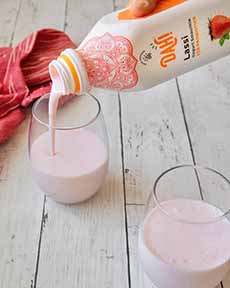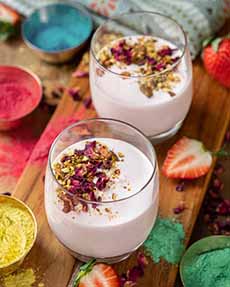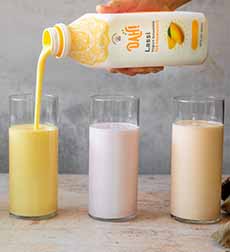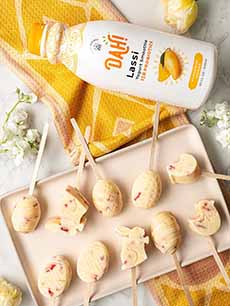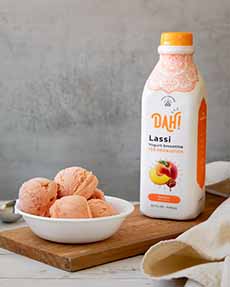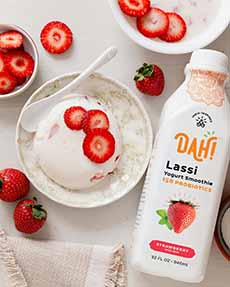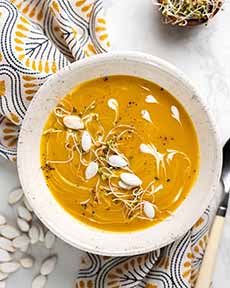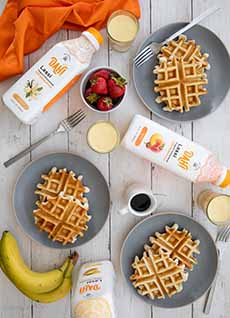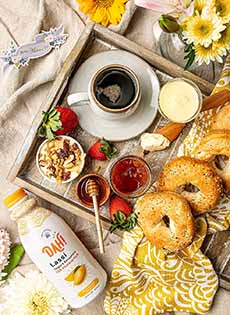What Is Lassi? Check Out Dah! Lassi Drink Made From Yogurt
|
|
Our Top Pick Of The Week is Dah! Lassi, a probiotic, yogurt-based drink. There are numerous ways to get more probiotics, and lassi (LAH-see) is a refreshing, tasty, way to do it. It’s also lactose-intolerance* friendly. Lassi, “the original smoothie,” is one of the most-drunk beverages in Northern India, after tea. You should consider it for your own beverage “menu.” It’s delicious (or Dah!licious, as the company likes to say). Lassi, a regional name for “yogurt drink,” is made from dahi, a traditional whole-milk yogurt from India that goes through a slow culturing process. Like other plain yogurts (the different types of yogurt), dahi-style yogurt is low in calories, high in probiotics, and filled with protein. Like other yogurts, it’s smooth and creamy. But due to the slow culturing process, plain dahi has a slightly sweeter flavor profile (i.e., it’s less tart). Dahi can be enjoyed by itself or used in cooking. It’s often used to make sweet or salty lassi. Lassi in turn can be used to make anything from dips to frozen desserts (photos #6 and #7). Check out all the recipes on the Dah! website. Trivia: Yogurt, and thus yogurt-based drinks, can be made from any mammal’s milk. Milk from camels, cows, goats, sheep, water buffalos, and yaks is used around the world. The taste and texture of the drink will vary widely depending on the milk. In the U.S., both lassi and kefir yogurt drinks are usually cow’s milk-based. The idea of the lassi drink is simple: Dahi is blended with water to thin it into drinkable yogurt (some historians believe that lassi may have been created as a way to stretch yogurt in the bowl, by stirring some liquid into it). The traditional way to serve lassi is in an unglazed terracotta cup called a kulhar or kulhad (photo #3). In India, lassi is served as an apéritif; drunk with meals; consumed as a quick breakfast, light lunch, or dessert (sweet lassi); and enjoyed as a healthful sweet or savory snack at any time of day. Plain or savory-flavored lassi is a perfect drink with spicy Indian food. Sweet lassi, perhaps blended with extra fruit and ice cubes—is a great smoothie. Below: If you don’t know lassi, you should get to know Dah!. Dah! was created by two natives of India living in the Boston area, who wanted the “feeling of home” provided by authentic lassi. Dah!’s products reflect the ancient Indian techniques of culturing yogurt at lower temperatures for longer times than most yogurt drinks. The result is a high-probiotic†, richly-textured, intensely flavorful yogurt that also happens to be excellent for digestive health. Dah! flavors include (photo #4): The flavors are available nationwide in 32-ounce bottles—here’s a store locator. In 2020, Dah! took home the Gold Sofi Award (the specialty food industry’s top award) in the yogurt and kefir category for Alphonso Mango lassi. The company also makes dahi, whole milk plain yogurt, and India-style almond yogurt. (We find the bottles so attractive that we repurpose the empties for other cold beverages—iced tea, iced coffee, iced water.) The flavors are delicious as is, but they also provide a blank canvas for you to make them even more flavorful and eye-appealing with garnishes. Make the drink even more special with herbs and spices. For a summer gathering, you can set up a sweet and savory lassi bar so guests can customize their own drinks. It will be a hit! The earliest mentions of lassi, promoting the health benefits of the yogurt beverage, have been found in the ancient Indian Ayurvedic texts dating as far back as 1000 B.C.E. The exact date can’t be pinpointed, but we know that yogurt was produced in Mesopotamia around 5000 B.C.E. Important trade routes were established between the two regions by 1000 B.C.E. The Middle East had its own version of the yogurt drink, kefir, which sources date to around 2000 B.C.E. See the differences in the next section. The modern lassi drink is believed to have originated in Punjab, a state of India located in the northwestern part of the subcontinent. When it appeared around 1000 B.C.E., some ancients called lassi the “food of the gods”* [source]. We moderns might choose to call it “refreshing and good for you.” According to Arun Chopra, formerly executive chef of the Taj Majal Palace Hotel: “In the old days, when there were no refrigerators, the Punjabi farmers used to drink milk cooled in a clay pot and mixed with curd [dahi/yogurt] and sugar and stirred by a wooden stick [source].” The drink spread to the rest of the world via the British Raj, which ruled the Indian subcontinent from 1858 to 1947. Returning military as well as civilians brought their favorite Indian dishes back to Great Britain and other parts of the British Empire. As with kefir, another yogurt-based beverage that originated in the Middle East, lassi can often be tolerated by lactose-intolerant people. The probiotic bacteria in both drinks compensate for the lack of an intolerant person’s production of lactase, the enzyme that digests milk proteins. Lassi is a simpler recipe than kefir. Buttermilk is a byproduct of milk, the liquid that is left over when butter is churned from cream. Lassi, on the other hand, is made from yogurt, which is milk that has been fermented with bacteria cultures. To make commercial buttermilk in quantity, milk is fermented with bacteria that produce acidic compounds, and is then pasteurized. That’s very similar to how yogurt is cultured (and then turned into lassi). Buttermilk has the texture of milk but tastes like yogurt, although it is less acidic. It’s thinner than lassi but can be slightly more sour or tart. Buttermilk and plain lassi can be substituted for each other in recipes. Enjoy every sip! |
|
|
_____________ *By contrast, in Greek mythology, ambrosia was the food of the gods: a dessert made of oranges and shredded coconut. The gods of other cultures had their own preferences. †The probiotic bacteria compensate for the lack of an intolerant person’s production of lactase, the enzyme that digests milk proteins. Probiotics have been proven to boost immunity, counter lactose intolerance, fight infection and fatigue, help with mineral absorption, promote digestive health, and support healthy cholesterol levels. Ayurvedic health practitioners have used lassi as a restorative for millennia. The cultures in Dah! include Streptococcus theramophilus, Bifidobacterium animals BB-12, Lacatobicilus acidophilus LA-5, Lactobacilus paracasei, and Propionibacterium freudenreichii. ‡Alphonso mangoes have a unique quality: They’re non-fibrous and very sweet and juicy. Other mango varieties are not typically eaten as hand fruit, biting into a ripe, raw Alphonso is a delicious treat. ‡‡A collaboration with Padma Lakshmi’s children’s book, the Tomato With Mixed Berries flavor pairs the sweetness of sun-dried tomatoes with the tartness of fresh berries.
|
||
